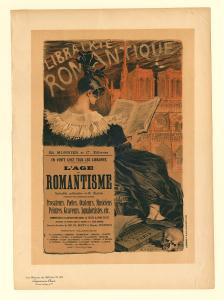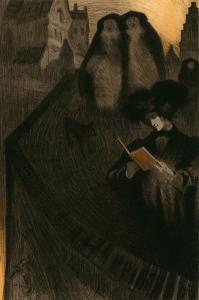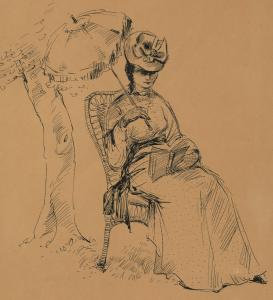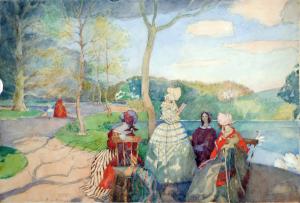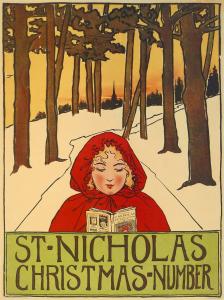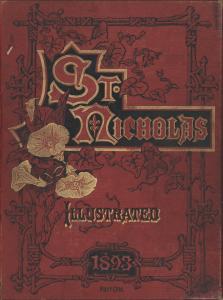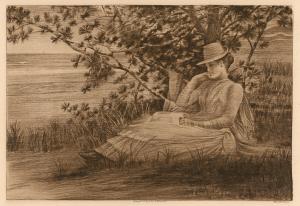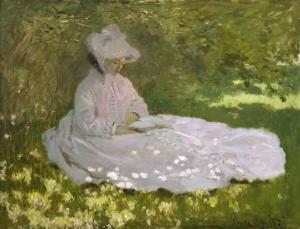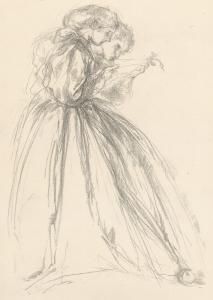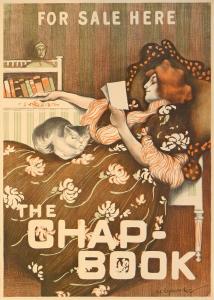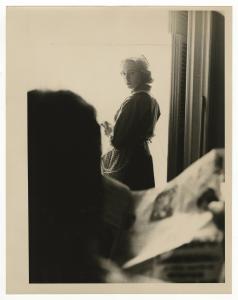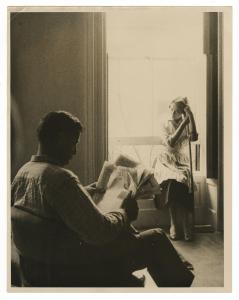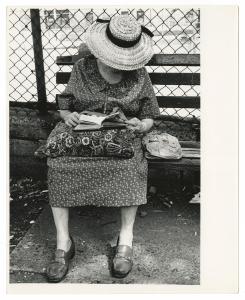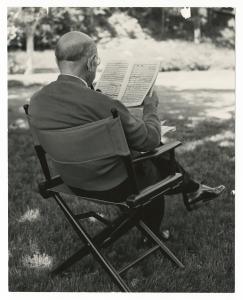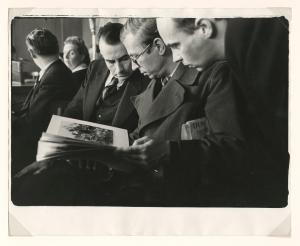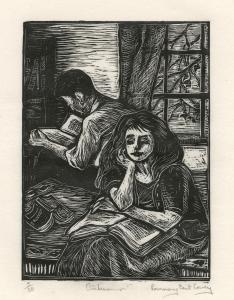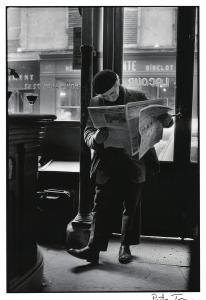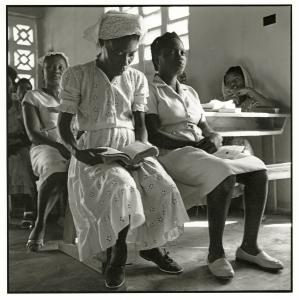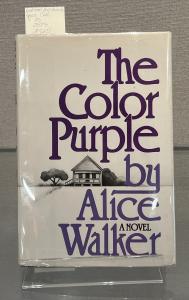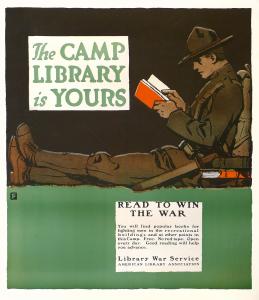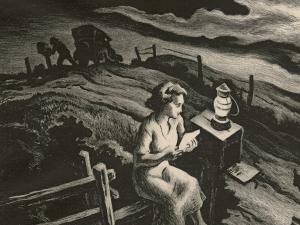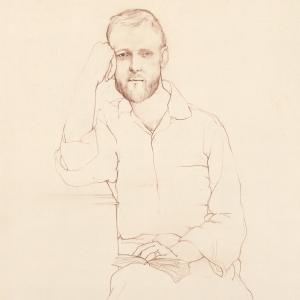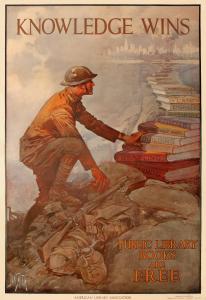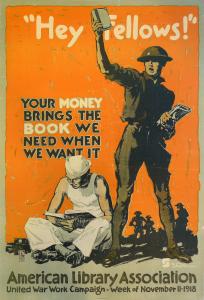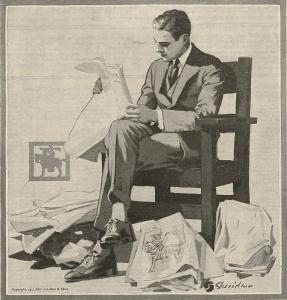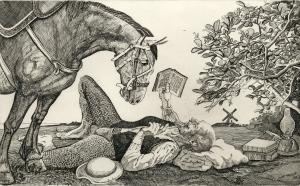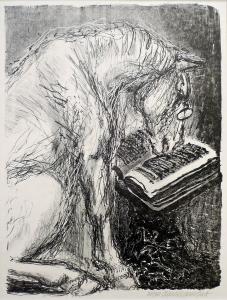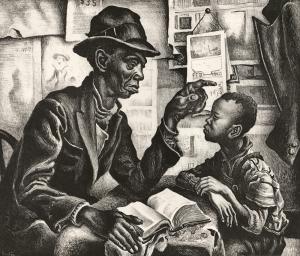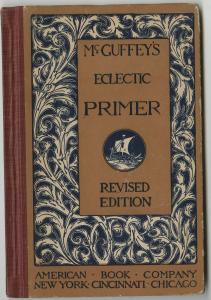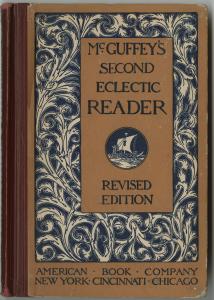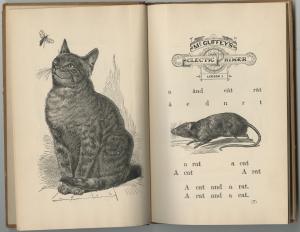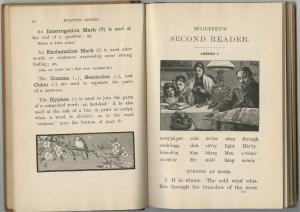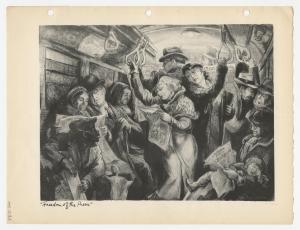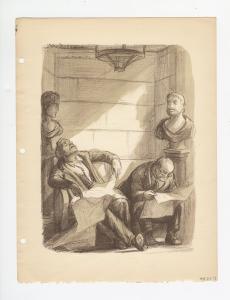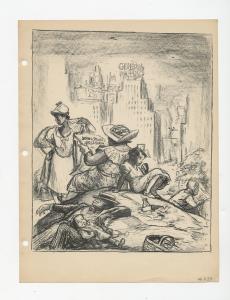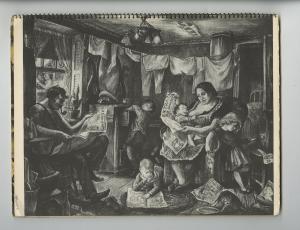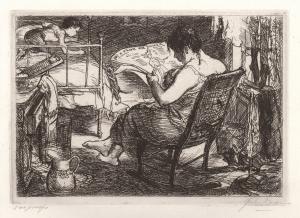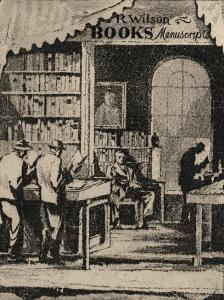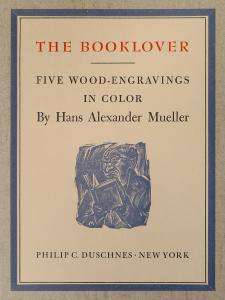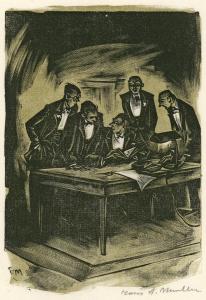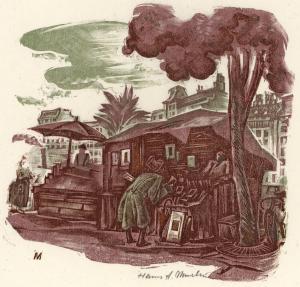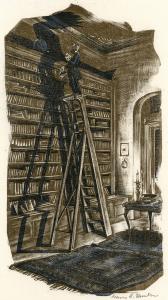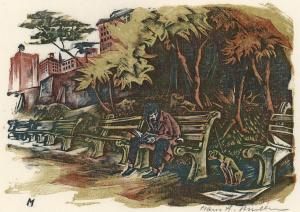Images of Reading from the University Art Collection
This exhibition is a celebration of a favored summer pastime. The artworks presented reveal all manner of individuals engaged in reading from books, letters, and printed matter in a not-to-distant time when tablets, cell phones and other digital media were not yet available. Before the Screen expands upon a 2011 exhibition in the library entitled Reveries on Reading. It includes newer acquisitions, most notably a transformative selection of fine art photography which began with annual donations from Jeff Perry (C’1982, Parent’2015) in 2010. Thanks to additional generous donors we are now able to include a variety of documentary photographs to provide a more updated perspective. In these and other works we encounter the joy and fulfillment in reading, which is not necessarily a solitary endeavor.
Before the Screen brings together an array of sub-themes including satire, whimsy, and literary inspiration. Spanning 100 years from the 1880s to the 1980s, these prints, photographs, posters and drawings encompass the genres of advertising, French art nouveau, and straightforward portrait studies. In these depictions of an essential aspect of human life, we can only imagine what is written on the pages that transport these readers to an inner realm.
Fairchild Gallery East Wall
Librairie Romantique
Eugène Grasset (1841 - 1917)
1896
Lithograph on paper
Art Collection purchase
2015.45.2
When this poster by Eugène Grasset was exhibited at the Salon des Cent in Paris it was hailed as the artist’s masterpiece. It was commissioned to advertise a series of books on the Romantic era published by Ed. Monnier & Cie. Grasset depicts a woman attired in 1830s clothing reading from a large volume with the cathedral of Notre-Dame in the background. To add to the Gothic theme, he included a skull at her feet.
(Reader) for Maîtres de l'Affiche
Georges De Feure (1868 – 1943)
1898
Lithograph on paper
Gift of Jim and Janet Sale
1996.38.3
This other-worldly image with a woman reading while two ghost-like figures hover above was part of a French subscription series known as Les Maitres de l’Affiche (Masters of the Poster). Totaling 240 lithographs and 16 special or bonus plates released between 1895 and 1900, Les Maitres was published by lithographer and poster artist Jules Chéret at his printing emporium Imprimerie Chaix in Paris. The series was circulated in sets of four lithographs per month as reduced size versions of colorful Art Nouveau advertising posters. This print by Georges De Feure was one of the four special plates in 1898 conceived as unique, original lithographs.
Untitled [Woman reading with umbrella]
Gerda Becker With (1910 – 2002)
ca. 1930
Ink on paper
Gift of Chris and Beverly With
2021.18.19
German-born artist Gerda Becker With studied at the Charlottenburg School of Art in Berlin and created illustrations for Ullstein Verlag, one of the largest publishing firms in Berlin. She emigrated to America in 1939 and married the German art historian and museum director Karl With and settled in Los Angeles. This ink drawing of a woman in Victorian style clothing was created early in her career, probably before she landed her position at Ullstein.
Dames Assises devant l'Étang (Women Sitting Beside a Pond)
Peter Alexandrovitch Nilouss (1869 – 1943)
ca. 1925
Watercolor on paper
Gift of Mrs. Valentine Golubovski
1111.194.1
Pierre Nilouss was born Petr Aleksandrovič Nilus in Odessa, southern Ukraine. He studied at the St. Petersburg School of Fine Arts and became a successful painter, working in a realist style while exhibiting for ten years with the Russian group known as the Peredvijniki, or itinerant painters. In 1919 Nilouss left his native country to travel for four years in the Balkans before settling permanently in Paris in 1924. The following year, the French art magazine L’Illustration published a short story entitled “The Emerald Night” with five watercolor illustrations by Nilouss, including this scene of a woman reading to a group of friends in an idyllic setting near a swan-inhabited lake. The style of this work is referred to by critics as his Russian romantic period. In France Nilouss became known for his landscapes and city views which he exhibited at salons and galleries throughout the city for the rest of his highly acclaimed career.
St. Nicholas, an illustrated magazine for young folks (vol. 22, pt. 1)
Mary Mapes Dodge (1830 – 1905)
(New York: The Century Co., 1893)
Booth Family Center for Special Collections
General 97A205
St. Nicholas Christmas Number
G. H. Buek & Company (1884 – 1891)
1896
Lithograph on paper
1111.1.684
St. Nicholas Illustrated Magazine, founded by Scribner's in 1873, was a popular children’s magazine that offered a variety of literature, illustrations, poems and history. Mary Mapes Dodge, its editor until 1905, wrote the popular children’s book Hans Brinker, or The Silver Skates. Dodge had very specific ideas of what a children’s magazine should be. As she explained, “Most children... attend school. Their heads are strained and taxed with the day’s lessons. They do not want to be bothered nor amused nor petted. They just want to have their own way over their own magazine.” Through personal friendships with important writers, Dodge secured a steady stream of contemporary fiction by authors such as Louisa May Alcott, Francis Hodgson Burnett, Mark Twain and Rudyard Kipling.
Reverie [Woman reading]
William St. John Harper (1851 – 1910)
1888
Etching on paper
Art Collection purchase
1998.16.1
William St. John Harper, a prominent nineteenth century New York painter and etcher, excelled at depicting women engaged in leisurely activities out of doors. This etching recalls similar views by Impressionist painters such as Berthe Morisot and Claude Monet. Portraying women and children in an outdoor setting was a popular convention in the Victorian era. The accompanying image is of the Monet painting titled Springtime (1872) in the collection of the Walters Art Museum in Baltimore.
The Letter
Charles Hazelwood Shannon (1863 – 1937)
1896
Lithograph on paper
Gift of John Rackham
1111.1.2227
Charles Shannon, a turn-of-the twentieth century British artist inspired by the Pre-Raphaelite movement and French symbolism, was championed by Elizabeth and Joseph Pennell in their influential book Lithography and Lithographers (1898). Together with his partner and colleague Charles Ricketts, Shannon published an artistic magazine called The Dial (1889-97) and established the Vale Press (1896-1904). The pair revolved in an artistic and literary enclave in Chelsea, and contributed design and decorations to Oscar Wilde’s The Importance of Being Earnest (Leonard Smiths and Co., 1899) and A House of Pomegranates (Osgood & McIlvaine, 1891). This delicate lithograph of two women huddled together over a letter was published in The Savoy, No. 1 (1896), and is in the collection of the British Museum.
Chap Book [Woman reading]
Joseph Christian Leyendecker (1874 – 1951)
1897
Lithograph on paper
1979.7.1
J.C. Leyendecker was one of the preeminent commercial illustrators of the first half of the twentieth century. Best known for his Saturday Evening Post covers, of which there are 322, Leyendecker also designed advertisements for men’s Arrow Shirt Collars from 1905 until about 1930 as well as other sartorial retailers, defining the look of the well-dressed American male. During World War I, Leyendecker created several outstanding posters in support of the bond effort and the Liberty Loan campaign.
This poster advertising The Chap-Book literary magazine is a product of French Art Nouveau and is not characteristic of Leyendecker’s mature style. It was created shortly after his return from Paris’s Académie Julian, where he was inspired by the popular poster designers Toulouse-Lautrec, Jules Chéret and Alfonse Mucha.
Fairchild Gallery West Wall
Woman in Apron Looking Back at Man Reading Newspaper with Disdain
Jacques Lowe (1930 – 2001)
1955 – 1965
Gelatin silver print (facsimile)
Gift of John Chatzky and Debbie Mullin
2019.12.11
Woman Staring at Man while Holding Broomstick (Wide Shot)
Jacques Lowe (1930 – 2001)
1955 – 1965
Gelatin silver print (facsimile)
Gift of John Chatzky and Debbie Mullin
2019.12.12
Jacques Lowe was an internationally renowned photographer and photo journalist known for his portraiture of the leading personalities of our time, in politics, business, and the entertainment world. He is perhaps best known as the official photographer of the Kennedy White House. In the 1950s, Lowe contributed photojournalistic work to a variety of publications including JUBILEE, LIFE, LOOK, Time, Newsweek, The Saturday Evening Post, and Ladies Home Journal. It is likely these two images on domestic inequality were made during this time.
Girls Reading Newspaper, Blackpool, England
Henri Cartier-Bresson (1908 – 2004)
1962 – 1967
Gelatin silver print (facsimile)
Gift of Jeffrey Perry
2018.11.9
Henri Cartier-Bresson, one of the most influential photographers of the twentieth century, is considered a pioneer of the genre known as street photography. He believed that success was dependent on the photographer’s intuitive ability to capture the “decisive moment.” This image of 5 women humorously reacting to a story in a newspaper probably relates to a film the photographer created in 1962 entitled Stop Laughing – This is England, shot in towns of the industrial north.
Reading on Park Bench, NYC
Erika Stone (b. 1924)
1970 – 1984
Gelatin silver print (facsimile)
Gift of John Chatzky and Debbie Mullin
2020.12.81
Erika Stone has had a long and successful career as a photo journalist and magazine photographer. She studied at the New School of Social Research with Berenice Abbott and George Tice and became affiliated with a socially motivated photography collective known as the Photo League. This experience inspired Stone to focus on documenting people. She contributed to Time and Der Spiegel magazines (among others) and had a successful career in photojournalism.
Pablo Casals, Marlboro, VT
Erika Stone (b. 1924)
1960 - 1965
Gelatin silver print (facsimile)
Gift of John Chatzky and Debbie Mullin
2019.12.27
The rural town of Marlboro, Vermont, is home to a summer educational musical program designed to enrich exceptional professional musicians in a collaborative setting. The renowned Spanish cellist, composer, and conductor Pablo Casals was invited to come to Marlboro for two weeks in 1960, which led to longer visits for the next 12 summers, up until his death at 97 in 1973.
Jean-Paul Sartre and Friends at an Auction, Paris
Henri Cartier-Bresson (1908 – 2004)
1944
Gelatin silver print (facsimile)
Gift of Jeffrey Perry
2018.11.13
In this intriguing scene, Cartier-Bresson captures a moment when three friends at an auction are staring fixedly at a book, perhaps a catalog of the sale. The central figure is the French existential philosopher and author Jean-Paul Sartre, who was then emerging as a famous writer and intellect. His first novel, Nausea, was published in 1938 and his highly influential trilogy, The Roads to Freedom, was published from 1945-1949. Cartier-Bresson made an iconic photo of Sartre standing on a Paris bridge in 1946. It was published on the cover of The Philosophy of Jean-Paul Sartre by Robert Cumming in 1965.
Two Women in a Sitting-Room
Henry Moore (1898 – 1986)
1983
Lithograph on paper
613/3000
Gift of Alfred and Pie Friendly
2019.7.1.20
This print is from a collection of 50 lithographs entitled Moore: a Cura di Carmine Benincasa, published in 1983 by Edizione SEAT. Henry Moore was a world- renowned British artist best known for his monumental, semi-abstract figural sculpture.
Autumn Reading
Rosemary Feit Covey (b. 1954)
1981
Wood engraving on paper
3/80
Gift of Eric Mackenzie in memory of William C. Garwood and Gwendolyn Garwood
2011.1.116
Rosemary Feit Covey is a prolific master of the wood engraving technique who works locally in Alexandria, Virginia. This piece showing a couple reading in their home was published in the Washington Post Book World on November 1, 1981.
Café Lacour, Rue de Saint Paul
Peter Turnley (b. 1955)
1976
Archival pigment print (facsimile)
Gift of Ertan Yenicay
2017.26.8
Peter Turnley is an award-winning international photojournalist whose work has been featured on more than 40 covers of Newsweek magazine. He has contributed to many journals and newspapers including Harper’s, National Geographic, Le Monde, and the New Yorker. He moved to Paris in 1975 and graduated from the Sorbonne. He has been documenting the life of Paris, where he has lived for more than half his life. This candid image of a gentleman reading in a Paris café calls to mind scenes from classic French films. The rue St. Paul is in the old Marais district which includes historic sites such as the Place des Vosges and the Bastille.
Haiti, (Women seated, one reading book) from the series Merci Gonaïves
Danny Lyon (b. 1942)
1983 – 1986
Gelatin silver print (facsimile)
Gift of Jeffrey Perry
2010.3.50
Danny Lyon is a famous American photographer and filmmaker who pioneered the genre of New Journalism in photography. In this approach the photographer becomes fully immersed and takes part in the subject of his documentary work. From 1983-86 Lyon lived in Haiti and created the series Merci Gonaïves, named for the northern village where revolutionary actions against Haiti’s repressive dictator Baby Doc Duvalier initially emerged. Lyon’s insightful series blends scenes of everyday life, like this image of two women, with those of revolutionary violence and unrest. His book, Merci Gonaïves: A Photographer's Account of Haiti and the February Revolution, was published in 1988.
A Reading by Alice Walker
Kate Thompson
1983
Commercial/offset printing on paper
Purchased with Funds from the Rare Books Collections
2021.27.1
This poster was created to promote a reading of the novel The Color Purple by Alice Walker. The event occurred at the University of Washington and was co-sponsored by Red and Black Books and the U.W. Women’s Studies Program. The novel about the misfortunes of a young, black girl growing up in rural Georgia in the early twentieth century received the Pulitzer Prize and the National Book Award for fiction in 1983.
The Color Purple: a novel
Alice Walker (b. 1944)
(New York: Harcourt, Brace, Jovanovich, 1982)
Booth Family Center for Special Collections
National Book Award; PS3573.A425 C6 1982p
Special Collections Gallery North Wall
The Camp Library is Yours: Read to Win the War
Charles Buckles Falls (1874 – 1959)
1918
Lithograph on paper
Donated by Pierce Butler (C'64), Jeff Carlson (C'08), David Fackler (SFS'66), David Fitzgerald (C'91), John Keane (B'79), Tony Kerbs (C'73), TJ Mattimore (C'92, L'96), and Rufino Mendo in honor of David J. Walsh (C'58)
1111.122.1
Charles Buckles Falls was a successful illustrator and author who created several military recruitment posters during the First World War. This poster for the American Library Association promoted the Library War Service’s program to support the troops with reading material. These donated books, magazines and even games helped to pass the time in camp libraries and trenches. And for some disadvantaged soldiers, the books offered an opportunity to gain literacy.
Letter from Overseas
Thomas Hart Benton (1889 – 1975)
1943
Lithograph on paper
The James P. Murphy Collection
1987.21.18
Thomas Hart Benton, a congressman’s son from Missouri, received his first training in art at Western High School in Georgetown, now the home of the Duke Ellington School of the Arts. After serving in World War I, he went on to become a famous American Regionalist painter. In this lithograph, Benton portrays a woman in a rural setting immersed in reading a letter, presumably from her loved one, illuminated by lamplight. During the Second World War, letters were the only means of communication between soldiers at the front and their families back home.
Reading Room of the New York Public Library
Theodore Peter Davies (1928 – 1993)
1982
Woodcut on paper
1111.1.685
The Rose Main Reading Room of the New York Public Library is shown here as a hub of activity, with dozens of patrons reading and researching. Davies was a painter, printmaker and photographer who studied at the Art Students League in New York and lived on Long Island.
Portrait Study: L.A.B.
Arthur Hall Smith (1929 – 2013)
ca. 1970s
Ink on paper (facsimilie)
1111.1.5403
The convention in portraits of showing the sitter with a book is meant to express the idea that the subject is educated or intellectual. Even more than the book “prop” in this extremely fine ink drawing, the subject’s direct and incisive gaze leaves the viewer in no doubt as to his intelligence. This portrait study depicts a friend of the artist’s named Louis Buck, who was also an artist.
Lewis Buck and Arthur Hall Smith were friends from high school and grew up in Norfolk Virginia. They both settled in Washington, D.C. where Smith taught at George Washington University. Buck and Smith participated in several Corcoran biennials and remained friends and colleagues for over 60 years.
Knowledge Wins: Public Library Books Are Free
Dan Smith (1865 – 1934)
1918
Lithograph on paper
Gift of Richard L. Hanley
2010.33.1
The three posters on this wall advertise the Library War Service, established by the American Library Association in 1917. The L.W.S. established 36 libraries across America and Europe, and distributed library books to over 500 additional locations during World War I.
People at home were encouraged to donate books as a direct contribution to the war effort, and those in active service were encouraged to take advantage of opportunities for enrichment and relaxation.
Hey Fellows
John E. Sheridan (1880 – 1948)
1918
Lithograph on paper
Gift of Richard L. Hanley
2010.33.2
A prolific illustrator of posters and advertisements whose images graced many covers of the Saturday Evening Post, John Sheridan created three well-known posters for the war effort. These were commissioned by the U.S. Shipping Board Emergency Fleet, the U.S. Food Administration, and the American Library Association. The latter circulated over 350,000 books overseas providing much needed literature to service men and women.
In this powerful image, a soldier energetically waves a library book above his head, signaling the anticipation and enthusiasm for books that brought connection to home and an outlet for the mind.
Hart Schaffner & Marx Advertisement: Reading the Newspaper
John E. Sheridan (1880 – 1948)
1922
Commercial/offset printing on paper
Gift of Richard J. Cellini
2015.4.55
John E. Sheridan, Georgetown Class of 1901, illustrated the seasonal stylebooks that advertised the collections of the Chicago men’s clothing store Hart, Schaffner & Marx, which manufactured officers’ uniforms.
Special Collections Gallery South Wall
Don Quixote Reading
Frank Wright (1932 – 2020)
1968
Engraving on paper
9/75
2010.31.12
The befuddled knight errant Don Quixote animatedly shares tales of chivalry with his trusty steed Rocinante, who indulges his enthusiasm.
Dr. Bucephalus
Claire Van Vliet (b. 1933)
1964
Lithograph on paper
20/30
Art Collection purchase
2000.12.5
Franz Kafka’s short parable The New Advocate describes the afterlife of Bucephalus, the horse of Alexander the Great. The horse, finding few opportunities for conquest in the modern world, turns instead to study and becomes a doctor of law (as was Kafka himself). Here he is shown reading a legal tome. In the words of Kafka:
“…it may really be best, perhaps, to do as Bucephalus has done and bury oneself in the law books. Free, his flanks unpressed by the thighs of a rider, under a quiet lamp, far from the din of Alexander’s battles, he reads and turns the pages of our old books.”
from The Complete Stories of Franz Kafka
Instruction
Thomas Hart Benton (1889 – 1975)
1940
Lithograph on paper
The James P. Murphy Collection
1987.21.14
Surrounded by throwaway printed matter, a man and boy ignore the flimsy pages around them and pointedly concentrate on the contents of the book between them. The book is thus a third partner in their conversation, in stark contrast to the pages on the walls which are worthy of little notice.
Please see our other Benton lithograph displayed alongside World War I posters for additional commentary on the artist.
McGuffey’s Eclectic Primer – Revised Edition and McGuffey’s Second Eclectic Reader – Revised Edition
William Holmes McGuffey (1800 – 1873)
(New York: American Book Company, 1909)
(New York: American Book Company, 1920)
On loan from the curator in memory of her mother,
Savannah Tunnell Walker
The McGuffey Readers were a popular series of textbooks for primary school often used in multi-age rural school houses. The series included a primer, a speller, and six progressive readers. The lessons were often moral in tone and included black and white images. Students also learned to transcribe printed text into handwritten cursive. First introduced in 1836, the McGuffey Readers were widely used in public schools until the early to mid-20th Century.
Freedom of the Press
Don Freeman (1908 – 1978)
Published in Don Freeman’s Newsstand (vol. 1, no. 3), 1937
Lithograph on paper
1995.21.1.3
Don Freeman, printmaker and illustrator of children’s books and newspaper articles, was captivated by life in New York, habitually sketching scenes and crowds wherever he went. Freeman studied at the Art Students League under John Sloan, whose etching The Women’s Page is displayed nearby. From Sloan he learned to depict a crowd of people as a composite entity, and the importance of storytelling in art. In this image one can sense the claustrophobic conditions on the New York subway, where almost all the passengers are engaged in some form of reading. They seem to pivot around the two central female figures; one straining over her shoulder to read the headlines of the newspaper behind her.
Freeman created this lithograph while employed at the W.P.A.’s Federal Art Project, in an edition of 25. This impression was released in Don Freeman’s Newsstand, a self-published magazine of graphic humor and social commentary that he sold by subscription beginning in 1936.
Untitled [Men with newspapers between sculptures]
Don Freeman (1908 – 1978)
Published in Don Freeman’s Newsstand (vol. 1, no. 4), 1937
Lithograph on paper
1995.21.2.13
Untitled [People relaxing and reading]
Don Freeman (1908 – 1978)
Published in Don Freeman’s Newsstand (vol. 1, no. 4), 1937
Lithograph on paper
1995.21.2.4
In this illustration for Freeman’s Newsstand, a periodical of lithographs, he captures a favorite New York activity: picnicking in Central Park. The actual location of this scene may be inferred from the General Motors sign on the tiered building in the background. The sign was installed around 1928 on the new GM headquarters at 1775 Broadway (at 58th Street), and was replaced in the 1980s by Hitachi when GM moved into a new building on Fifth Avenue.
Career of a Racketeer Part I: Beginning at Home
Don Freeman (1908 – 1978)
Published in Don Freeman’s Newsstand (vol. 1, no. 5), 1937
Lithograph on paper
1997.1.107.10
Freeman’s satiric exposé on New York’s criminal underworld was conceived in two parts: “Beginning at Home” shown here, and “Full Fledged,” bound in the same volume. In this leisurely family scene, the parents are engaged in reading newspaper reports of murder and bank theft while one child seizes the opportunity to steal from the contents of a drawer. Another child lying on the floor studies a story titled “Love Crazed,” while a third fiddles with the radio in apparent boredom.
The Women’s Page
John Sloan (1871 – 1951)
1905
Etching on paper
Art Collection purchase
1981.4.7
The creator of more than 300 etchings, John Sloan was a master of the technique and one of the leading American artists of the early twentieth century. As observed by Jacob Kainen in the catalogue of John Sloan’s etchings, “He was the witty observer who found an essential humanity in the commonplace.” Between 1905 and 1906, Sloan created ten etchings for a series entitled New York Life which were strikingly modern in their unvarnished depiction of contemporary life. Part of this series, The Women’s Page was in fact rejected—along with three others—from an exhibition of the American Watercolor Society, for being “vulgar” and “indecent.” The woman and child depicted were tenants in a furnished apartment behind Sloan’s 23rd Street studio. One of the artist’s favorite prints, he considered it “the best all-around example, both in subject matter and treatment.”
Untitled [Wilson's Bookstore – signed proof]
Earl Horter (1881 – 1940)
1933
Aquatint on paper
Art Collection purchase
1996.13.3
Horter created this image for publication in The Colophon: A Book Collector’s Quarterly. At the time, The Colophon was still printed with high-quality original art prints alongside the text; soon afterwards, however, the financial pressures of the Depression forced a reduction in quality.
The Booklover
Hans Alexander Müller (1888 – 1963)
Not dated
Wood engraving on paper
Gift of Grace Haller
1991.31.1.0
In contrast with the bustle of Davies’s Library on display in this exhibition, Müller’s five images here depict a largely solitary pursuit. These scenes are far from calm, however: staccato, decisive lines combine with forceful light-dark contrasts in presenting the book as an object of desire, and the experience of books and reading as high drama no less grand for its intimate nature.
Curated by LuLen Walker, Art Curator
Production assistance by Christen Runge, Assistant Art Curator
Webpage by Gabby Nemarich, G'26
Art matting by Frames by Rebecca

